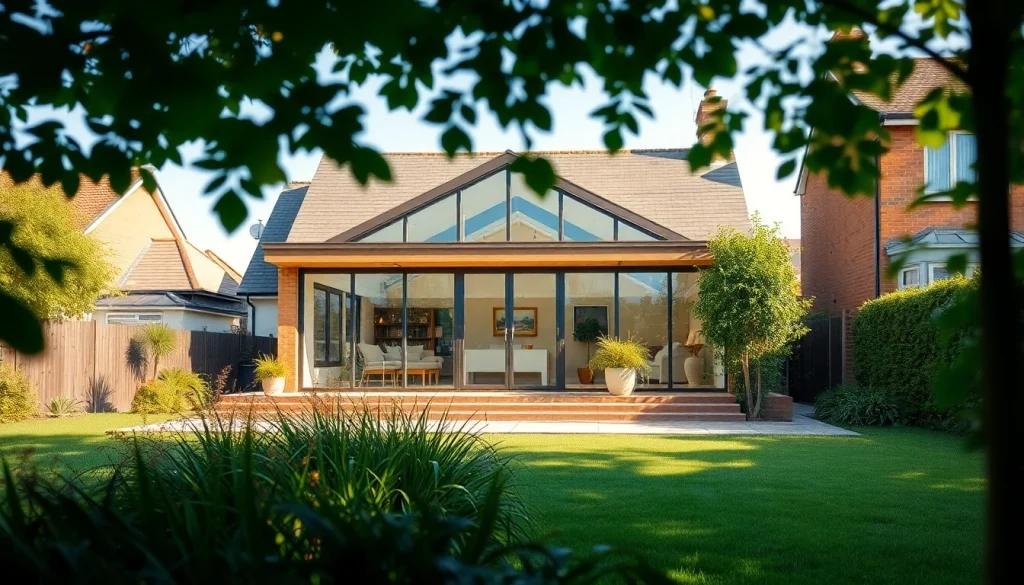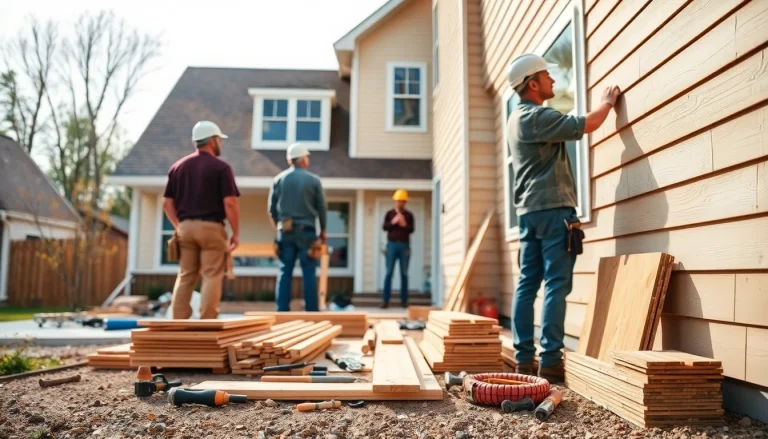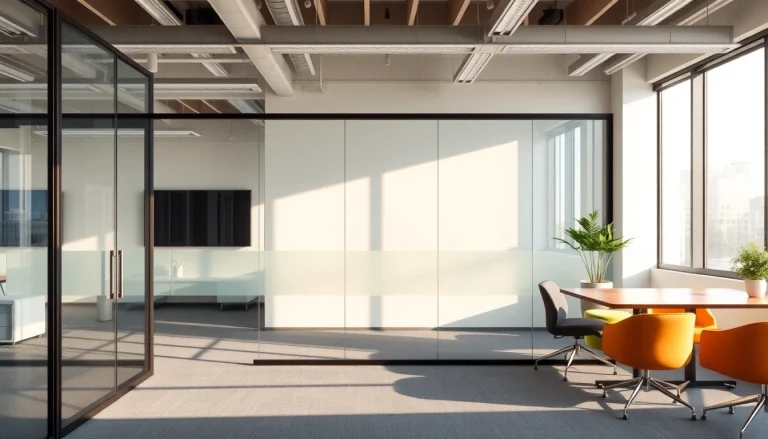
Understanding Residential Extensions
What Are Residential Extensions?
Residential extensions are structures added to existing homes to expand living space, enhance functionality, or improve aesthetic appeal. These additions can take various forms, including single-storey extensions, double-storey extensions, loft conversions, and basement developments. Whether you’re looking to create an open-plan kitchen, additional bedrooms, or a home office, residential extensions offer a versatile solution to meet modern lifestyle demands. Homeowners in urban areas often prefer extensions as they allow them to stay in their beloved neighborhoods while upgrading their properties. For more information on residential extensions, you can explore our resources here.
Benefits of Adding a Residential Extension
Adding a residential extension can significantly enhance your living experience and provide a myriad of benefits, including:
- Increased Space: Extensions can create additional living areas, accommodating growing families or evolving needs.
- Increased Property Value: Well-planned extensions can enhance the resale value of your home, often yielding a substantial return on investment.
- Customization: Homeowners can design extensions to their specifications, ensuring the new space integrates seamlessly with the existing home and reflects their personal style.
- Avoiding the Hassle of Moving: Extensions enable families to stay in their desirable community without the stress, costs, and disruptions associated with relocating.
- Maximizing Land Use: Extensions make excellent use of available land, particularly in urban settings where space is at a premium.
Types of Residential Extensions
There are numerous types of residential extensions to consider, each serving distinct functions and catering to various budgets and preferences:
- Single-Storey Extensions: These are popular for kitchens or dining areas, allowing for wide, open spaces and greater connectivity to gardens.
- Double-Storey Extensions: More extensive and offering more potential living space, these extensions can add significant value if executed well.
- Loft Conversions: Utilizing attic space to create bedrooms or home offices, loft conversions are an increasingly popular choice in urban homes.
- Basement Conversions: Particularly in London, converting basements into functional living areas can maximize space without affecting the garden area.
- Wrap-Around Extensions: A combination of rear and side extensions, these transform the entire back of the house into a spacious, open living area.
Planning Your Residential Extension
Key Factors to Consider Before Starting
Planning a residential extension involves careful consideration of several factors to ensure a successful project:
- Purpose: Clearly define what you hope to achieve with the extension. This clarity will guide your design and planning decisions.
- Zoning and Regulations: Understand local zoning laws and building codes that may affect your project.
- Space Analysis: Assess the available land and how an extension would fit into your property, maintaining balance and aesthetic appeal.
- Impact on Neighbors: Consider how your extension may affect light, views, and privacy for neighboring properties.
- Design Integration: Ensure the design seamlessly integrates with the existing architecture and landscape.
Budgeting for Residential Extensions
Creating a comprehensive budget is crucial for the success of your residential extension project. Here are key components to include:
- Design Fees: Allocate funds for architects or designers who will be instrumental in crafting your vision.
- Construction Costs: Estimate materials, labor, and any additional contractor fees.
- Permits and Legal Fees: Account for any local permits required, as well as potential legal costs associated with zoning issues.
- Contingency Funds: Set aside at least 10-20% of your budget for unexpected expenses that may arise during the construction process.
- Interior and Landscaping Costs: Don’t forget to budget for interior finishes and landscaping once the extension is complete.
Obtaining Necessary Permits
Before commencing with construction, it’s vital to secure all necessary permits. This process may involve:
- Building Permits: Check with local authorities to determine if your project requires a building permit and what documentation you need to provide.
- Zoning Clearances: Ensure your proposed extension complies with zoning regulations, including height restrictions and setback requirements.
- Design Approvals: If your home is in a conservation area or is classified as a historic building, you may need special approvals for your design.
Designing the Perfect Residential Extension
Choosing the Right Materials
The choice of materials plays a crucial role in the overall success of your residential extension. You should consider:
- Durability: Select materials that will withstand the test of time and resist weathering.
- Insulation: Ensure the materials chosen contribute to effective insulation, enhancing comfort and efficiency in heating and cooling.
- Style Compatibility: Match materials to your existing home’s style, ensuring a cohesive look.
- Maintenance: Opt for low-maintenance materials where possible, saving time and energy in the long run.
Integrating Modern Design Trends
When designing your extension, consider incorporating current trends that not only enhance style but also functionality:
- Open-Plan Spaces: Emphasize open layouts that promote natural light and create a feeling of spaciousness.
- Sustainable Design: Utilize eco-friendly materials and construction practices, contributing to environmental sustainability.
- Smart Home Technology: Integrate smart features that allow for automation and increased energy efficiency.
- Biophilic Design: Incorporate natural elements and ample greenery into your space to enhance well-being and connection with nature.
Working with an Architect
Collaborating with a skilled architect can significantly enhance your project. Benefits include:
- Expert Design Solutions: Architects can create innovative designs that maximize space and meet your specific needs.
- Regulatory Knowledge: They are well-versed in local laws and can help you navigate the permitting process.
- Project Management: Many architects offer project management services, ensuring that your project runs smoothly from conception to completion.
Executing Your Residential Extension Project
Finding the Right Contractors
Choosing the right contractors is crucial for the successful execution of your residential extension. Consider the following:
- Experience: Look for contractors with a proven track record in residential extensions.
- References: Request references from previous clients to gauge quality and reliability.
- Transparent Communication: Ensure they are communicative, addressing your concerns and keeping you updated throughout the project.
- Written Contracts: Secure detailed contracts to outline the scope of work, timelines, and payment schedules, minimizing misunderstandings.
Project Timeline and Management
A clear project timeline is essential for staying on track. Key steps include:
- Initial Planning: Outline your project phases, from design to completion, setting realistic timelines for each.
- Regular Updates: Schedule regular check-ins with your contractor to address any delays or changes promptly.
- Quality Control: Conduct inspections at different stages of construction to ensure quality and adherence to plans.
Common Challenges and Solutions
While undertaking a residential extension can be exciting, it may also present challenges. Be prepared with these solutions:
- Bidding War: Secure your contractors ahead of time to avoid delays due to increased demand.
- Budget Overruns: Maintain a contingency fund and be realistic about what can be achieved within your budget to minimize overruns.
- Construction Delays: Anticipate potential weather-related delays by factoring in extra time in your project schedule.
Enhancing Value with Residential Extensions
Increasing Property Value
Investing in a well-planned residential extension boosts not only your available living space but also your property’s market value. When considering reselling, keep in mind:
- Market Trends: Extensions that meet local market demands can yield higher returns when selling.
- Professional Design: Homes designed by professionals tend to appeal to buyers and can command premium prices.
- Functional Space: Extensions offering additional bedrooms or living space are particularly attractive to family buyers.
Using Extensions for Rental Opportunities
Extensions can open doors to additional income through rental opportunities. Options include:
- Separate Entrances: Converting part of your home into a rental unit with its own entrance can attract tenants searching for independent living arrangements.
- Short-Term Rentals: Spaces added for vacation rentals can generate substantial income in tourist-heavy areas.
Marketing Your Enhanced Home
Once your extension is complete, effective marketing can help maximize your return on investment:
- High-Quality Photography: Use professional photos showcasing both the interior and exterior of your extended home, highlighting its new features.
- Digital Listings: Utilize various online platforms and social media to promote your property, detailing its new offerings.
- Engage with Potential Buyers: Hosting open houses can facilitate immediate interest and discussions about the improvements made.






